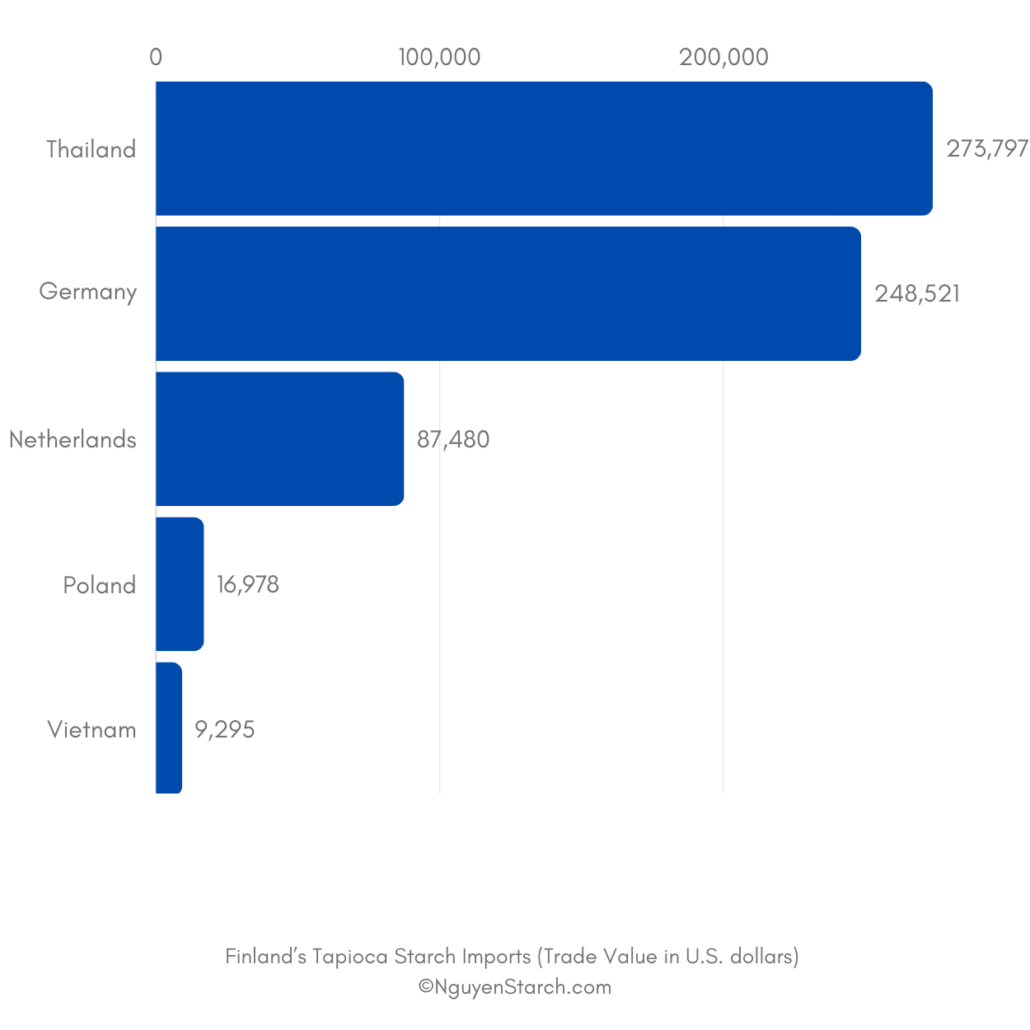Finland’s involvement in the tapioca starch trade reflects its moderate presence as both an exporter and importer of this commodity. While Finland’s tapioca starch exports remain modest, its imports from countries like Thailand, Germany, and the Netherlands demonstrate the country’s growing demand for tapioca starch.
Finland’s Tapioca Starch Exports
In 2021, Finland exported a modest $83 worth of tapioca starch, ranking as the 94th largest exporter globally. Tapioca starch held the 4255th position among Finland’s most exported products, indicating its limited significance within the country’s export profile.
The primary destinations for Finland’s tapioca starch exports were the Netherlands, with imports valued at $57, and Sweden, with imports valued at $26. These markets absorbed the majority of Finland’s tapioca starch exports.
Between 2020 and 2021, Finland experienced growth in its tapioca starch exports to the Netherlands, with an increase of $29. Sweden also demonstrated positive growth during this period, maintaining a steady value of $26. These developments reflect Finland’s expanding presence in these markets and its efforts to increase tapioca starch exports.
| Continent | Country | Trade Value |
| Europe | Netherlands | 57 |
| Europe | Sweden | 26 |
Finland’s Tapioca Starch Imports
In 2021, Finland imported $668k worth of tapioca starch, positioning itself as the 56th largest global importer of this product. Tapioca starch ranked 3005th on Finland’s list of imported goods, highlighting its moderate significance within the country’s import landscape.

Finland primarily sourced tapioca starch from Thailand, accounting for a substantial portion valued at $274k. Germany, the Netherlands, Poland, and Brazil were also noteworthy import partners, supplying respective values of $249k, $87.5k, $17k, and $15.2k.
Between 2020 and 2021, Finland experienced notable growth in its import market for tapioca starch from Germany, with an increase of $247k. Thailand and the Netherlands also demonstrated growth, with increases of $157k and $43.8k, respectively. These developments signify Finland’s increasing reliance on these countries to fulfill its tapioca starch requirements.
| Continent | Country | Trade Value |
| Africa | Cameroon | 34 |
| Africa | Ghana | 320 |
| Africa | Nigeria | 115 |
| Asia | China | 1,447 |
| Asia | Hong Kong | 185 |
| Asia | Sri Lanka | 52 |
| Asia | Thailand | 273,797 |
| Asia | Vietnam | 9,295 |
| Europe | Germany | 248,521 |
| Europe | Estonia | 48 |
| Europe | France | 43 |
| Europe | United Kingdom | 1,685 |
| Europe | Netherlands | 87,480 |
| Europe | Poland | 16,978 |
| Europe | Sweden | 12,709 |
| North America | United States | 31 |
| South America | Brazil | 15,183 |
Tariffs
As of 2017, Finland faced an average tariff rate of 27.8% on tapioca starch imports. Notably, the countries with the highest import tariffs on tapioca starch were the Republic of the Congo, Cape Verde, Algeria, Western Sahara, and Gabon. These nations applied a Most Favoured Nation duty rate treatment of 47.9%, posing challenges to Finland’s tapioca starch imports.
Importing Tapioca Starch from Vietnam
Vietnam has emerged as a prominent supplier of tapioca starch to the Finland market. In 2021, the total value of tapioca starch imports from Vietnam amounted to an impressive $9,295. This significant figure indicates that Vietnam’s tapioca starch holds a strong position in the market and is poised to maintain its presence in Finland in the years to come. The reasons behind this sustained importation are primarily attributed to the product’s superior quality and competitive pricing.
Finland benefits from Vietnam’s tapioca starch exports, which provide a dependable supply of this vital ingredient. The substantial import value from Vietnam underscores Finland’s confidence in Vietnam as a trusted and preferred partner for fulfilling its tapioca starch requirements. With its consistent quality and competitive pricing, Vietnam’s tapioca starch has proven to be a reliable source that meets Finland’s demand for this essential product.
Source: BACI and General Statistics Office of Vietnam
